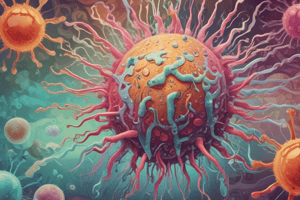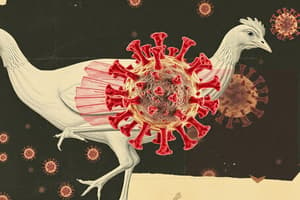Podcast
Questions and Answers
What is the result of antigenic shift in influenza viruses?
What is the result of antigenic shift in influenza viruses?
- Drastic reassortment leading to a pandemic (correct)
- Mild reassortment leading to an epidemic
- Formation of a new strain of influenza
- No change in the influenza virus
What type of influenza virus causes epidemics every 3-6 years?
What type of influenza virus causes epidemics every 3-6 years?
- Avian influenza
- Type B (correct)
- Type A
- Type C
What is the property of the Hepatitis virus that allows it to have high frequency recombination?
What is the property of the Hepatitis virus that allows it to have high frequency recombination?
- Enveloped virion
- Helical capsid symmetry
- Deletion mutation (correct)
- Non-segmented genome
What is the name of the virus that causes hepatitis?
What is the name of the virus that causes hepatitis?
What is the shape of the Paramyxovirus virion?
What is the shape of the Paramyxovirus virion?
What is the shape of the Coronavirus virion?
What is the shape of the Coronavirus virion?
What is the mode of infection for Paramyxovirus?
What is the mode of infection for Paramyxovirus?
What is the genome type of the Coronavirus?
What is the genome type of the Coronavirus?
What is the disease caused by swelling of the airways and problems breathing?
What is the disease caused by swelling of the airways and problems breathing?
What is the mode of transmission of MERS-CoV?
What is the mode of transmission of MERS-CoV?
What is the site of multiplication for Paramyxovirus?
What is the site of multiplication for Paramyxovirus?
What is the diagnosis method for Filovirus?
What is the diagnosis method for Filovirus?
What is the fatality rate of MERS-CoV?
What is the fatality rate of MERS-CoV?
What is the result of antigenic drift in influenza viruses?
What is the result of antigenic drift in influenza viruses?
What is the shape of the Picornavirus virion?
What is the shape of the Picornavirus virion?
What is the virion shape of the Filovirus?
What is the virion shape of the Filovirus?
What is the mode of transmission of Dengue fever?
What is the mode of transmission of Dengue fever?
What is the family of viruses that includes Coxsackie virus?
What is the family of viruses that includes Coxsackie virus?
What is the genome type of the Flavivirus?
What is the genome type of the Flavivirus?
What is the host cell affected by the Coronavirus?
What is the host cell affected by the Coronavirus?
What is the method used to confirm repeatedly reactive samples?
What is the method used to confirm repeatedly reactive samples?
What is the shape of the HIV virion?
What is the shape of the HIV virion?
What is the basis of HIV disease staging?
What is the basis of HIV disease staging?
What is the site of HIV multiplication?
What is the site of HIV multiplication?
What is the method used to determine viral load?
What is the method used to determine viral load?
What is the primary mode of transmission of the rabies virus?
What is the primary mode of transmission of the rabies virus?
What is the natural host of the Simian immunodeficiency virus (SIV)?
What is the natural host of the Simian immunodeficiency virus (SIV)?
What is the distribution of HIV-1?
What is the distribution of HIV-1?
What is the primary receptor for the HIV virus?
What is the primary receptor for the HIV virus?
What is the shape of the HIV virion?
What is the shape of the HIV virion?
What is the result of the destruction of T cells by the HIV virus?
What is the result of the destruction of T cells by the HIV virus?
What is the role of CXCR 4 and CCR5 in the HIV virus?
What is the role of CXCR 4 and CCR5 in the HIV virus?
What is the characteristic of the HIV genome?
What is the characteristic of the HIV genome?
What is the stage of the HIV infection where the patient remains asymptomatic for many years?
What is the stage of the HIV infection where the patient remains asymptomatic for many years?
What is the mode of transmission of the HIV virus?
What is the mode of transmission of the HIV virus?
What happens to the host's immune function during the clinical latency stage?
What happens to the host's immune function during the clinical latency stage?
What is the primary tissue infected by the virus?
What is the primary tissue infected by the virus?
How does the virus migrate to the CNS?
How does the virus migrate to the CNS?
What is the outcome of AIDS-associated infections in humans?
What is the outcome of AIDS-associated infections in humans?
What is used to diagnose AIDS?
What is used to diagnose AIDS?
What is the first stage of the disease?
What is the first stage of the disease?
What is a common symptom of the sensory excitement phase?
What is a common symptom of the sensory excitement phase?
What is a complication of AIDS-associated infections?
What is a complication of AIDS-associated infections?
What type of virus is involved in AIDS?
What type of virus is involved in AIDS?
Flashcards are hidden until you start studying
Study Notes
Hepatitis Viruses
- Virulence factor: high frequency recombination (Deletion mutation)
- Diagnosis: RT-PCR, Antigen-Detection Kits, Antibody Testing
Coronavirus
- Family: Coronaviridae
- Virion: enveloped, “pear-shaped” peplomers giving a crown-like appearance
- Largest RNA virus
- Genomic characteristics: non-segmented, (+) sense, ssRNA
- Multiplication: R (CYTOPLASM); AM (ER)
- Infects: upper respiratory tract
- MOT: respiratory droplet
- Contains S protein (spike) which causes cell fusion and facilitates viral entry to host cells
Filovirus
- Family: Filoviridae
- Virion: Filamentous, thread-like, enveloped with large peplomers, helical capsid sometimes irregularly shaped
- Genomic characteristics: non-segmented, (-) sense, ssRNA, striated core
- Multiplication: RA (CYTOPLASM); M (CM)
- Infects: macrophages, endothelial cells, hepatocytes
- MOT: respiratory droplets and body fluids
- Diseases: Ebola virus - short virus with 2-21 days incubation, Marburg virus - long virus with 4-16 days incubation
Influenza Viruses
- Type A, B, and C
- Diseases: primary influenza pneumonia, croup, otitis media
- Antigenic shift: drastic reassortment, every 10-40 years, leads to a pandemic
- Antigenic drift: mild reassortment, accumulated point mutations lead to formation of new strain
- Examples of Influenza Epidemics and Pandemics: Spanish flu (1918-1919), Russian flu, Asian flu (1957), Hong Kong flu (1968)
Flavivirus
- Family: Flaviviridae
- Virion: spherical, enveloped, icosahedral
- Genomic characteristics: non-segmented, (+) sense, ssRNA
- Multiplication: R (CYTOPLASM); AM (ER)
- Infects: macrophages (Dengue), CNS (Encephalitis), Hepatocytes (HCV & yellow fever)
- MOT: Aedes aegypti (Dengue), Arthropod bite (Encephalitis), parenteral (HCV), Aedes or Haemagogus spp.
Paramyxovirus
- Family: Paramoxyviridae
- Virion: spherical, helical capsid, enveloped, HA, NA spikes
- Genomic characteristics: non-segmented, linear, (-) sense, ssRNA
- Multiplication: RA (CYTOPLASM); M (CM)
- Infects: epithelial cells of the respiratory tract
- MOT: respiratory droplets
- Latency: None
- Diseases: URTI, croup, bronchiolitis, pneumonia
Picornavirus
- Family: Picornaviridae
- Virion: naked, icosahedral capsid
- Genomic characteristics: non-segmented, linear, (+) sense, ssRNA
- Multiplication: RAM (CYTOPLASM)
- Infects: oropharynx, GIT, heart, pleura
- MOT: respiratory droplets
- Diseases: Coxsackie virus - enterovirus from New York, HAV - enterovirus causing hepatitis, Poliovirus, Rhinovirus
Retrovirus (HIV)
- Family: Retroviridae
- Genomic characteristics: linear, non-segmented, (+) sense, ssRNA, diploid (presence of DNA and RNA)
- Multiplication: R (NUCLEUS) wherein RNA is transcribed to DNA; AM (CYTOPLASM)
- Infects: CD4+ cells
- MOT: sexual, parenteral
- Diseases: HIV-1 - cosmopolitan distribution; HIV-2 - common in West Africa
Rabies Virus
- Family: Rhabdoviridae
- Virion: enveloped, rod-shaped or bullet-shaped, helical capsid symmetry
- Genomic characteristics: non-segmented, (-) sense, ssRNA
- Multiplication: R (CYTOPLASM); AM (CM)
- Infects: Muscle (initial replication) and neurons
- MOT: infectious saliva, aerosol
- Diseases: Rabies (madness, rage, fury)
HTLV
- Family: Retroviridae
- Genomic characteristics: non-segmented, linear, (+) sense, ssRNA
- Multiplication: R (NUCLEUS) wherein RNA is transcribed to DNA; AM (CYTOPLASM)
- Infects: CD4+ cells
- MOT: sexual, parenteral
- Diseases: HTLV-1, HTLV-2
Studying That Suits You
Use AI to generate personalized quizzes and flashcards to suit your learning preferences.





